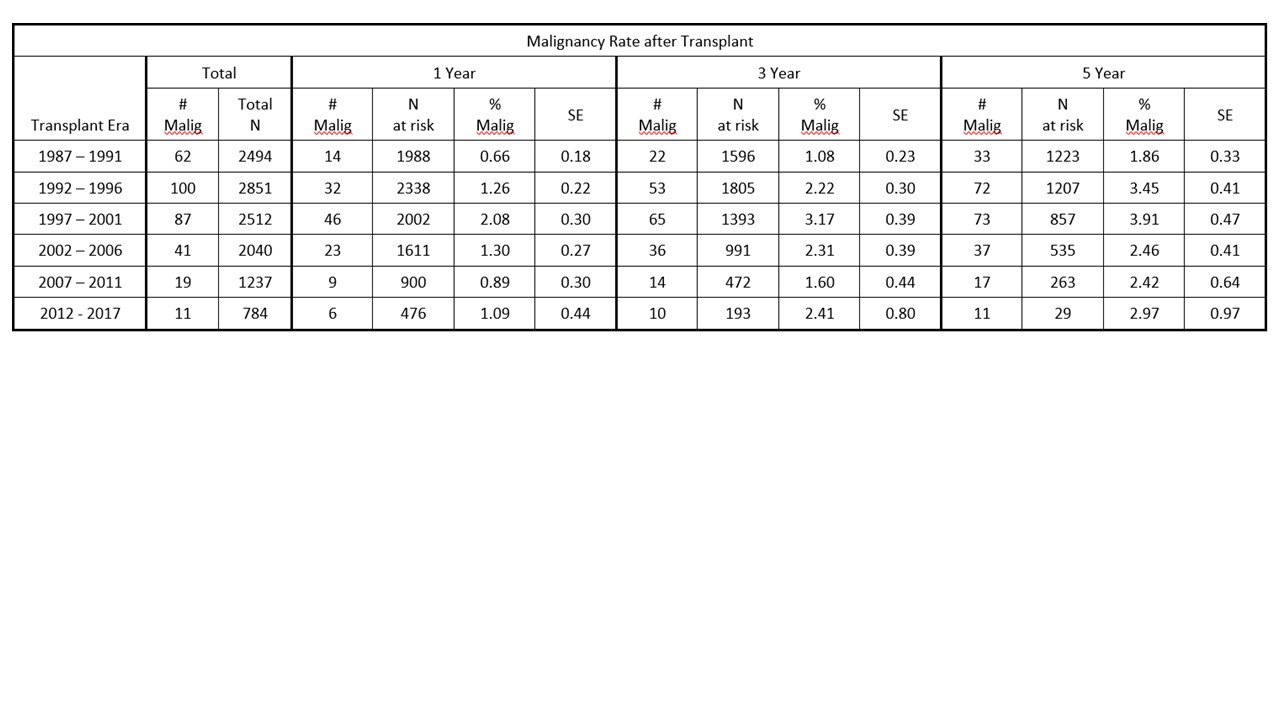Steadily Dropping Malignancy Rates after Pediatric Kidney Transplantation Have Now Reversed in the Most Recent Era: A Report of the North American Pediatric Renal Trials and Collaborative Studies (NAPRTCS)
1Washington University in St. Louis, Saint Louis, MO, 2Mayo Clinic, Rochester, MN, 3Duke University, Durham, NC, 4Children's National Medical Center, Washington, DC, 5Emmes Corporation, Rockville, MD, 6BC Children's Hospital, Vancouver, BC, Canada, 7Seattle Children's Hospital, Seattle, WA, 8Johns Hopkins University, Baltimore, MD
Meeting: 2019 American Transplant Congress
Abstract number: D332
Keywords: Kidney transplantation, Pediatric, Post-transplant lymphoproliferative disorder (PTLD)
Session Information
Session Name: Poster Session D: PTLD/Malignancies: All Topics
Session Type: Poster Session
Date: Tuesday, June 4, 2019
Session Time: 6:00pm-7:00pm
 Presentation Time: 6:00pm-7:00pm
Presentation Time: 6:00pm-7:00pm
Location: Hall C & D
*Purpose: In general, malignancies are very rare in children, compared to older adults. The NAPRTCS registry has collected data on children receiving kidney transplants in North America since 1987. The registry has served to document and influence practice patterns, clinical outcomes, and changing trends in several outcomes, including malignancy.
*Methods: Data are submitted voluntarily by centers on patients transplanted before their 21st birthday, at the time of transplant, one and six months post-transplant, and every six months thereafter. Collected data include peri-transplant information, donor and recipient characteristics, immunosuppression, acute rejection (AR), malignancy, height, graft and patient survival. Donor and recipient EBV serostatus is not tracked. This analysis reports on the outcomes up to the end of December 2017.
*Results: Malignancies have been reported in 320 patients to the NAPRTCS registry since 1987. The type of malignancy was post-transplant lymphoproliferative disorders in 268/320 (84%). The 1-year, 3-year and 5-year rates of malignancy are shown in the Table. After a peak rate in 1997-2001, rates dropped in subsequent eras. However, as shown in the table, the 1-year, 3-year and 5-year rates have all reversed, higher in the most recent era (2012-2017) than the prior era 2007-2011. Compared to 2007-2011, the 2012-2017 overall cohort had more 2-5 year old children (p<0.003), more use of alemtuzumab, tacrolimus, mycophenolate (all p <0.001), but no differences in 1-year acute rejection, recipient race or gender, or donor source.
*Conclusions: The sudden reversal in malignancy rates is concerning. The most recent era has a relatively lower rate of enrolled patients and the 5-year results in this cohort are limited, so must be interpreted with caution. Further vigilance and analysis to clarify the transplant risk factors is required.
To cite this abstract in AMA style:
Dharnidharka V, Cramer C, Chua A, Moudgil A, Martz K, Blydt-Hansen T, Smith J, Neu A. Steadily Dropping Malignancy Rates after Pediatric Kidney Transplantation Have Now Reversed in the Most Recent Era: A Report of the North American Pediatric Renal Trials and Collaborative Studies (NAPRTCS) [abstract]. Am J Transplant. 2019; 19 (suppl 3). https://atcmeetingabstracts.com/abstract/steadily-dropping-malignancy-rates-after-pediatric-kidney-transplantation-have-now-reversed-in-the-most-recent-era-a-report-of-the-north-american-pediatric-renal-trials-and-collaborative-studies-nap/. Accessed December 27, 2025.« Back to 2019 American Transplant Congress

